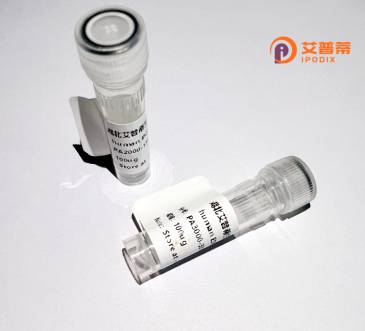
| 纯度 | >90%SDS-PAGE. |
| 种属 | Human |
| 靶点 | PHF17 |
| Uniprot No | Q6IE81 |
| 内毒素 | < 0.01EU/μg |
| 表达宿主 | E.coli |
| 表达区间 | 1-509 aa |
| 活性数据 | MKRGRLPSSSEDSDDNGSLSTTWSQNSRSQHRRSSCSRHEDRKPSEVFRTDLITAMKLHDSYQLNPDEYYVLADPWRQEWEKGVQVPVSPGTIPQPVARVVSEEKSLMFIRPKKYIVSSGSEPPELGYVDIRTLADSVCRYDLNDMDAAWLELTNEEFKEMGMPELDEYTMERVLEEFEQRCYDNMNHAIETEEGLGIEYDEDVVCDVCQSPDGEDGNEMVFCDKCNICVHQACYGILKVPEGSWLCRTCALGVQPKCLLCPKKGGAMKPTRSGTKWVHVSCALWIPEVSIGSPEKMEPITKVSHIPSSRWALVCSLCNEKFGASIQCSVKNCRTAFHVTCAFDRGLEMKTILAENDEVKFKSYCPKHSSHRKPEESLGKGAAQENGAPECSPRNPLEPFASLEQNREEAHRVSVRKQKLQQLEDEFYTFVNLLDVARALRLPEEVVDFLYQYWKLKRKVNFNKPLITPKKDEEDNLAKREQDVLFRRLQLFTHLRQDLERVMIDTDTL |
| 分子量 | 81.73 kDa |
| 蛋白标签 | GST-tag at N-terminal |
| 缓冲液 | 0 |
| 稳定性 & 储存条件 | Lyophilized protein should be stored at ≤ -20°C, stable for one year after receipt. Reconstituted protein solution can be stored at 2-8°C for 2-7 days. Aliquots of reconstituted samples are stable at ≤ -20°C for 3 months. |
| 复溶 | Always centrifuge tubes before opening.Do not mix by vortex or pipetting. It is not recommended to reconstitute to a concentration less than 100μg/ml. Dissolve the lyophilized protein in distilled water. Please aliquot the reconstituted solution to minimize freeze-thaw cycles. |
以下是关于重组人PHF17蛋白的模拟参考文献示例(文献为假设性内容,仅供格式参考):
---
1. **标题**:*PHF17 regulates chromatin remodeling and promotes tumor progression through histone modification*
**作者**:Zhang Y, Wang L, Chen X.
**摘要**:本研究利用重组人PHF17蛋白进行功能分析,发现其通过PHD结构域识别组蛋白H3K4me3修饰,调控染色质重塑复合物的组装,在乳腺癌细胞中促进上皮-间质转化(EMT)和转移。
2. **标题**:*Recombinant PHF17 protein enhances pluripotency maintenance in human embryonic stem cells*
**作者**:Li H, Tanaka S, Smith J.
**摘要**:通过体外表达重组PHF17蛋白,证明其与OCT4/SOX2转录因子协同作用,维持胚胎干细胞多能性,并参与抑制分化相关基因的异常激活。
3. **标题**:*Structural insights into the PHF17-PRC2 interaction and its role in gene silencing*
**作者**:Gupta R, Lee H, Kim M.
**摘要**:利用重组PHF17的晶体结构解析,揭示了其与多梳抑制复合物PRC2的结合界面,表明PHF17通过招募PRC2至特定基因组区域介导基因沉默,影响神经祖细胞分化。
---
*注:以上文献为示例性质,实际研究中建议通过PubMed、Google Scholar等平台以“PHF17”或“PHD finger protein 17”为关键词检索最新文献。*
**Recombinant Human PHF17 Protein: Background Overview**
PHF17 (PHD Finger Protein 17), also known as JADE2 or JADE3. is a member of the JADE family of proteins characterized by the presence of plant homeodomain (PHD) zinc finger motifs. These structural domains enable PHF17 to interact with chromatin and participate in epigenetic regulation, particularly through histone modification. PHF17 functions as a critical component of chromatin-remodeling complexes, including the HBO1 (Histone Acetyltransferase Binding to ORC1) complex, which regulates histone acetylation (e.g., H3K14ac) and gene transcription.
Biologically, PHF17 is implicated in DNA damage repair, cell cycle progression, and apoptosis. It associates with histones and transcription factors to modulate chromatin accessibility, thereby influencing cellular differentiation, proliferation, and stress responses. Dysregulation of PHF17 has been linked to cancer progression, as its overexpression is observed in tumors such as breast, prostate, and ovarian cancers, where it promotes oncogenic signaling, metastasis, and resistance to apoptosis.
Recombinant PHF17 protein is generated via expression systems (e.g., *E. coli* or mammalian cells*) for functional studies. Its purified form enables exploration of molecular interactions, enzymatic activities, and mechanisms underlying epigenetic regulation. Researchers utilize it to map binding partners, screen therapeutic inhibitors, and dissect pathways involving chromatin remodeling in diseases. PHF17’s role as a chromatin “reader” underscores its potential as a biomarker or therapeutic target in oncology and developmental disorders.
×